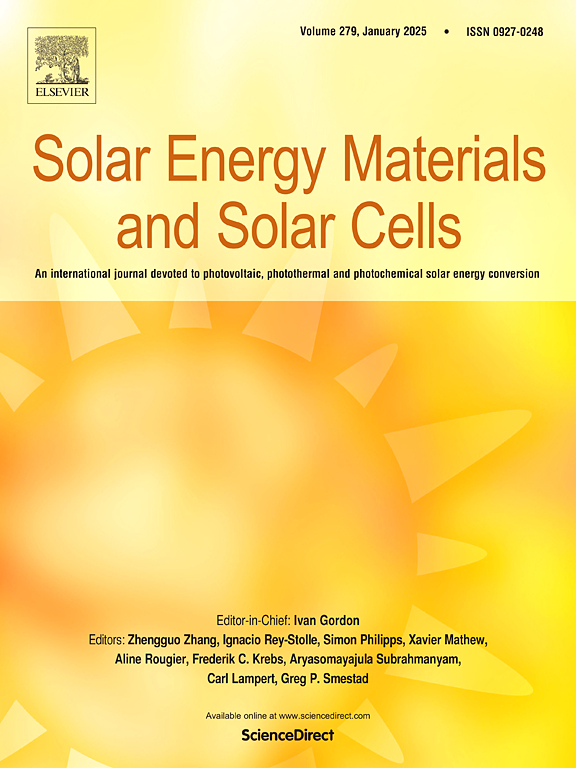隐藏的痕迹:洞察太阳能电池处理如何驱动HJT和TOPCon模块的湿热故障
IF 6.3
2区 材料科学
Q2 ENERGY & FUELS
引用次数: 0
摘要
隧道氧化物钝化接触(TOPCon)是目前主导的光伏技术,异质结(HJT)太阳能电池由于其优越的效率有望迅速获得市场份额。然而,TOPCon和HJT电池仍然容易受到湿度引起的降解,特别是当封装在前玻璃/后背板结构时。本研究调查了“隐藏污染物”在HJT和TOPCon玻璃背板模块中湿热(DH)诱导降解中的作用,而在类似条件下生产的钝化发射极和后电池(PERC)模块中没有观察到这种影响。“隐藏的污染物”不是故意引入的,它们的存在通常只有在加速检测后才会明显。经过1000小时的DH测试,TOPCon和HJT电池对“隐藏污染物”都表现出高度的显著敏感性,导致相对功率损失为10 - 16%。元素分析确定钠(Na),钙(Ca),镁(Mg),氯(Cl)和硫(S)可能是贡献者。假设这些污染物来自电池或模块处理过程中的(不当)处理,例如接触受污染的手套,盒式磁带,包装或真空夹具。在湿热测试条件下,Na+、Ca2+、Mg2+、Cl−和S2−等离子可能与湿气以及太阳能电池的钝化层和/或金属触点发生化学反应。这些反应促进了载流子的重组,并导致金属触点的腐蚀,最终降低了器件的性能。为了尽量减少这些影响,强烈建议进行彻底的去离子水清洗,严格遵守使用未污染的手套、卡带、包装材料或真空夹具的处理方案,并在封装前专门使用清洁阶段。这些发现强调了TOPCon和HJT太阳能电池相对较高的灵敏度,因此对严格的污染控制至关重要,以防止在现场发生意外故障,特别是对于具有一系列太阳能电池供应商的组件制造商。本文章由计算机程序翻译,如有差异,请以英文原文为准。
Hidden traces: Insights into how solar cell handling drives damp-heat failures in HJT and TOPCon modules
Tunnel oxide passivated contact (TOPCon) is now the dominant photovoltaic technology and heterojunction (HJT) solar cells are expected to rapidly gain market share due to their superior efficiencies. However, both TOPCon and HJT cells remain vulnerable to humidity-induced degradation, especially when encapsulated in front-glass/rear-backsheet configurations. This study investigates the role of “hidden contaminants” in damp heat (DH)-induced degradation in HJT and TOPCon glass-backsheet modules while observing no such effects in passivated emitter and rear cell (PERC) modules that are produced under comparable conditions. “Hidden contaminants” are not deliberately introduced, and their presence is typically only evident after accelerated testing. After 1000 h of DH testing, both TOPCon and HJT cells displayed a high significant sensitivity to “hidden contaminants”, resulting in relative power losses of 10–16 %. Elemental analysis identified sodium (Na), calcium (Ca), magnesium (Mg), chlorine (Cl), and sulphur (S) as likely contributors. These contaminants are hypothesised to originate from (improper) handling during cell or module processing, such as contact with contaminated gloves, cassettes, packaging, or vacuum grippers. Under damp heat testing conditions, ions such as Na+, Ca2+, Mg2+, Cl−, and S2− are likely to chemically react with moisture as well as with the passivation layers and/or metal contacts of solar cells. These reactions promote carrier recombination and induce corrosion of the metal contacts, ultimately degrading device performance. To minimise these effects, thorough deionised water cleaning, strict adherence to handling protocols using uncontaminated gloves, cassettes, packaging material, or vacuum grippers, and the exclusive use of clean stages prior to encapsulation are strongly recommended. These findings underscore the relatively high sensitivity of TOPCon and HJT solar cells and thus place critical importance on stringent contamination control to prevent unexpected failure in the field, in particular for module manufacturers with a range of solar cell suppliers.
求助全文
通过发布文献求助,成功后即可免费获取论文全文。
去求助
来源期刊

Solar Energy Materials and Solar Cells
工程技术-材料科学:综合
CiteScore
12.60
自引率
11.60%
发文量
513
审稿时长
47 days
期刊介绍:
Solar Energy Materials & Solar Cells is intended as a vehicle for the dissemination of research results on materials science and technology related to photovoltaic, photothermal and photoelectrochemical solar energy conversion. Materials science is taken in the broadest possible sense and encompasses physics, chemistry, optics, materials fabrication and analysis for all types of materials.
 求助内容:
求助内容: 应助结果提醒方式:
应助结果提醒方式:


